我们继续我们上一节的前端入门之(vue图片加载框架一)往下~~
上一节我们最后已经把框架的基本构造弄完了,最后也能够看到我们的效果了:
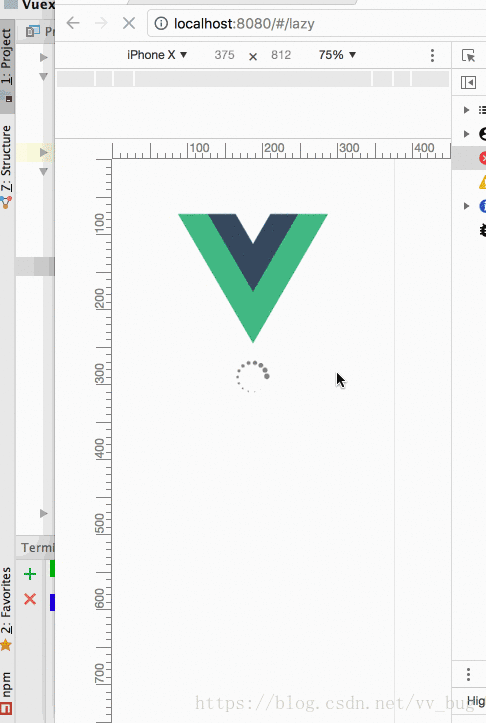
可以看到,我们已经简单的实现了我们的占位图的功能了,然后代码很简单:
<template>
<div class="opt-container">
<img v-lazy="{src:111+images[1]}">
</div>
</template>
<script>
export default {
name: 'Lazy',
data() {
return {
images: [
'https://timgsa.baidu.com/timg?image&quality=80&size=b9999_10000&sec=1533137283186&di=c136f7387cfe2b79161f2f93bff6cb96&imgtype=0&src=http%3A%2F%2Fpic1.cxtuku.com%2F00%2F09%2F65%2Fb3468db29cb1.jpg',
'https://timgsa.baidu.com/timg?image&quality=80&size=b9999_10000&sec=1533137283186&di=de941561df3b6fd53b2df9bfd6c0b187&imgtype=0&src=http%3A%2F%2Fpic43.photophoto.cn%2F20170413%2F0008118236659168_b.jpg',
'https://timgsa.baidu.com/timg?image&quality=80&size=b9999_10000&sec=1533137283185&di=aff7e8aa60813f6e36ebc6f6a961255c&imgtype=0&src=http%3A%2F%2Fimg.zcool.cn%2Fcommunity%2F01d60f57e8a07d0000018c1bfa2564.JPG%403000w_1l_2o_100sh.jpg',
]
}
}
}
</script>
<!-- Add "scoped" attribute to limit CSS to this component only -->
<style scoped>
.opt-container {
font-size: 0px;
}
</style>
好啦,代码写到这,我们可以发现,当我们的图片第一次加载的时候会走指令的bind方法,然后我们走了add方法,紧接着就去加载图片,那么如果图片加载完毕了,我们再去修改这张图片链接的时候,会发生什么呢?
<template>
<div class="opt-container">
<img v-lazy="{src: currImg}">
</div>
</template>
<script>
const IMAGES = [
'https://timgsa.baidu.com/timg?image&quality=80&size=b9999_10000&sec=1533137283186&di=c136f7387cfe2b79161f2f93bff6cb96&imgtype=0&src=http%3A%2F%2Fpic1.cxtuku.com%2F00%2F09%2F65%2Fb3468db29cb1.jpg',
'https://timgsa.baidu.com/timg?image&quality=80&size=b9999_10000&sec=1533137283186&di=de941561df3b6fd53b2df9bfd6c0b187&imgtype=0&src=http%3A%2F%2Fpic43.photophoto.cn%2F20170413%2F0008118236659168_b.jpg',
'https://timgsa.baidu.com/timg?image&quality=80&size=b9999_10000&sec=1533137283185&di=aff7e8aa60813f6e36ebc6f6a961255c&imgtype=0&src=http%3A%2F%2Fimg.zcool.cn%2Fcommunity%2F01d60f57e8a07d0000018c1bfa2564.JPG%403000w_1l_2o_100sh.jpg',
]
export default {
name: 'Lazy',
data() {
return {
currImg: IMAGES[0]
}
},
mounted() {
setTimeout(() => {
this.currImg=IMAGES[1]
}, 1000)
}
}
</script>
可以看到,我们在mounted里面延时了1s然后替换了图片,我们运行看看:
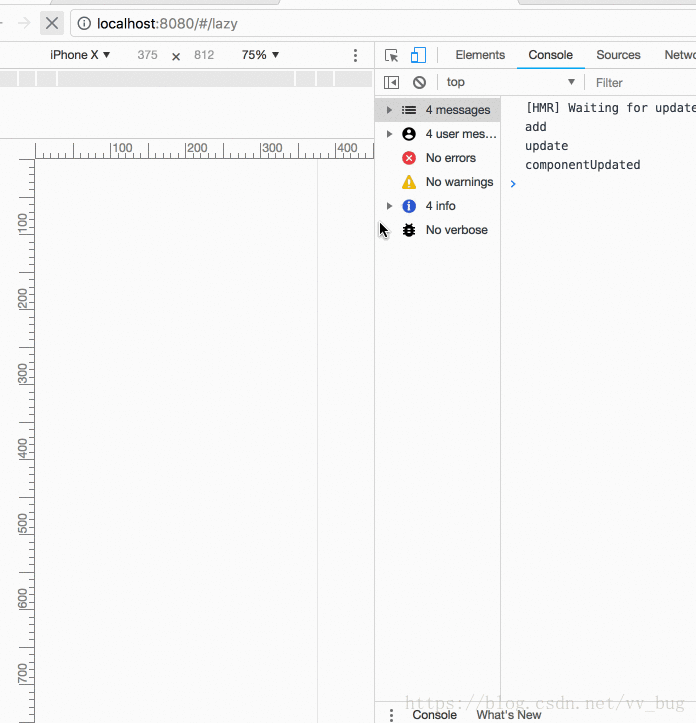
可以看到,我们1s后图片并没有改变,然后执行了指令的update方法:
...
update
componentUpdated那么我们怎么才能改变图片呢? 有一招!! 我们修改一下代码:
<template>
<div class="opt-container">
<img v-lazy="{src: currImg}" v-if="showImage">
</div>
</template>
<script>
const IMAGES = [
'https://timgsa.baidu.com/timg?image&quality=80&size=b9999_10000&sec=1533137283186&di=c136f7387cfe2b79161f2f93bff6cb96&imgtype=0&src=http%3A%2F%2Fpic1.cxtuku.com%2F00%2F09%2F65%2Fb3468db29cb1.jpg',
'https://timgsa.baidu.com/timg?image&quality=80&size=b9999_10000&sec=1533137283186&di=de941561df3b6fd53b2df9bfd6c0b187&imgtype=0&src=http%3A%2F%2Fpic43.photophoto.cn%2F20170413%2F0008118236659168_b.jpg',
'https://timgsa.baidu.com/timg?image&quality=80&size=b9999_10000&sec=1533137283185&di=aff7e8aa60813f6e36ebc6f6a961255c&imgtype=0&src=http%3A%2F%2Fimg.zcool.cn%2Fcommunity%2F01d60f57e8a07d0000018c1bfa2564.JPG%403000w_1l_2o_100sh.jpg',
]
export default {
name: 'Lazy',
data() {
return {
currImg: IMAGES[0],
showImage: true
}
},
mounted() {
setTimeout(() => {
this.showImage=false
this.$nextTick(()=>{
this.currImg=IMAGES[1]
this.showImage=true
})
}, 3000)
},
beforeUpdate(){
console.log('beforeUpdate')
}
}
</script>
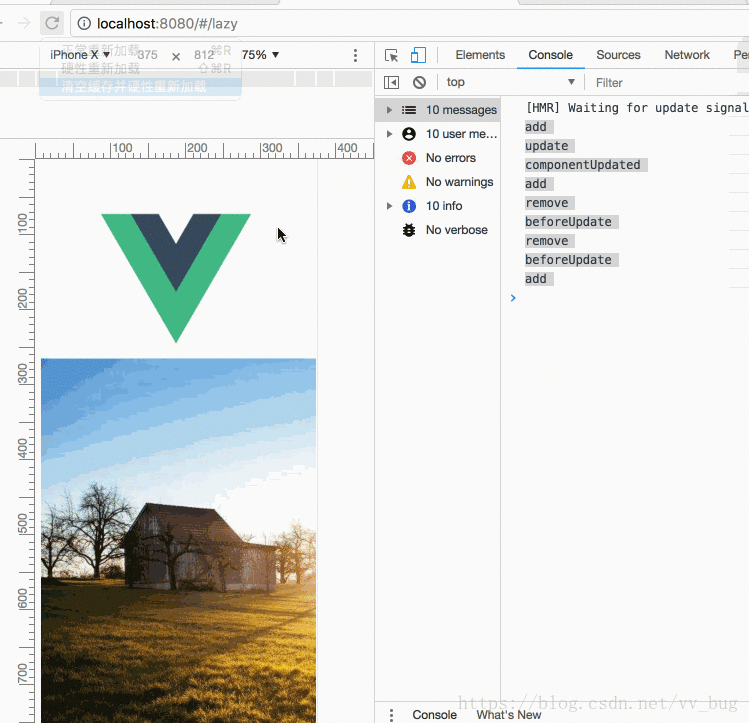
可以看到,我们其实做的操作是让vnode销毁了,然后又重新创建了一个vnode,就相当于重新走了一遍add方法,所以加载出来了,但是这很明显不是我们想要的结果,因为这样对内存消耗很大,我们直接在之前的vnode中判断,当src与之前的src不同的时候,重新加载一下图片就好了,我们从log中就可以看到,每次vnode发生变换的时候,就会走指令的update方法,update完毕后会走componentUpdated方法:
add
beforeUpdate
update
componentUpdatedinstall(Vue, options = {}) {
let LazyClass = lazyDelegate(Vue);
let lazy = new LazyClass(options);
Vue.directive('lazy', {
bind: lazy.add.bind(lazy),
update: lazy.update.bind(lazy),
componentUpdated: function () {
console.log('componentUpdated');
},
unbind: lazy.remove.bind(lazy),
})
}我们直接执行下lazy的update方法,componentUpdated我们后面再实现~~
LazyDelegate.js:
update(el, binding) {
console.log('update');
}我们都知道,我们的LazyDelegate充当的是一个manager的角色,然后我们对每个img的操作都在listener.js(经纪人)那边,所以我们直接在manager里面调listener的update方法:
LazyDelegate.js
update(el, binding) {
console.log('update');
let {src, loading, error} = this._valueFormatter(binding.value)
//找出经纪人(listener)是否之前存在
let exsit
for (let i = 0; i < this.ListenerQueue.length; i++) {
let listener = this.ListenerQueue[i]
if (listener.el === el) {
exsit = listener
break
}
}
//如果存在就调用listener的update方法
if(!!exsit)exsit.update({src,loading,error})
}listener.js:
update({src, loading, error}) {
const oldSrc = this.src
this.src = src
this.loading = loading
this.error = error
if (oldSrc !== src) {
alert('src变了,我们需要重新加载img')
}
}
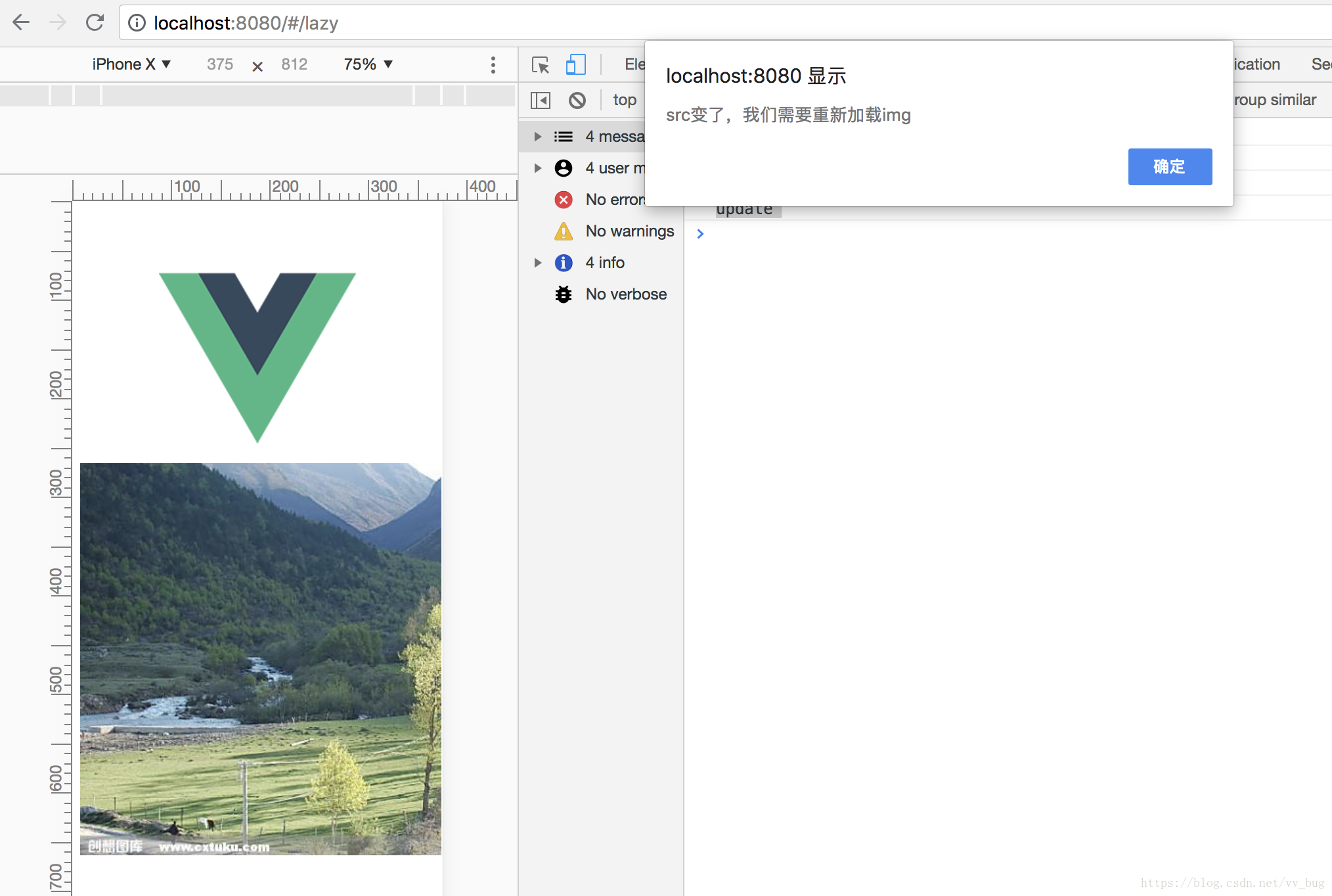
我们需要在listener的update方法中重置图片的各个状态:
update({src, loading, error}) {
const oldSrc = this.src
this.src = src
this.loading = loading
this.error = error
if (oldSrc !== src) {
//重置load状态
this.initState()
//重置重试次数
this.attempt = 0
}
}然后我们在LazyDelegate.js中的update方法中,重新加载图片:
update(el, binding) {
console.log('update');
let {src, loading, error} = this._valueFormatter(binding.value)
//找出经纪人(listener)是否之前存在
let exsit
for (let i = 0; i < this.ListenerQueue.length; i++) {
let listener = this.ListenerQueue[i]
if (listener.el === el) {
exsit = listener
break
}
}
//如果存在就调用listener的update方法
if(!!exsit)exsit.update({src,loading,error})
//重新加载图片
Vue.nextTick(() => this.lazyLoadHandler())
}然后我们运行看效果:
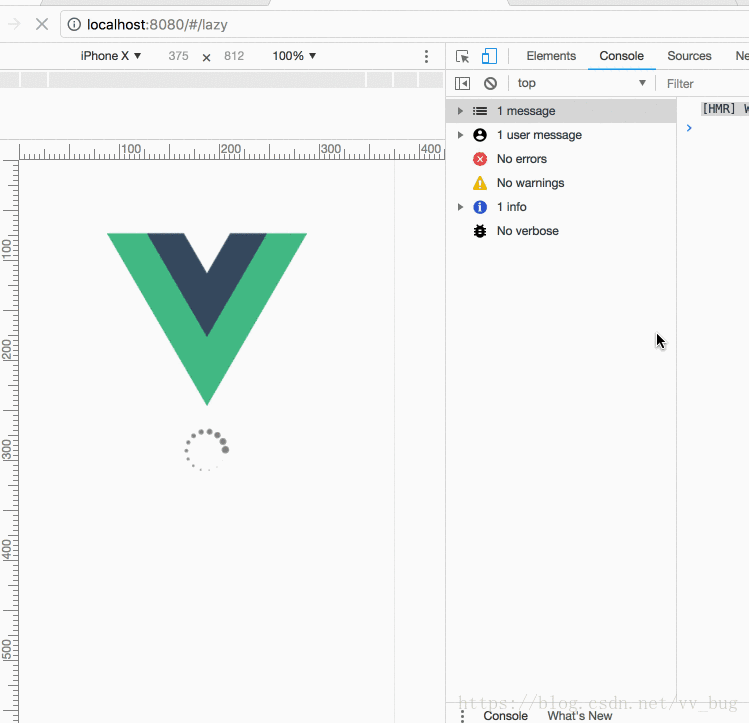
可以看到,我们已经实现了我们想要的效果了,然后当我们的指令执行componentUpdated方法的时候,我们直接重新加载一遍img,然后当我们remove的时候,我们需要释放所有资源:
index.js
export default {
install(Vue, options = {}) {
let LazyClass = lazyDelegate(Vue);
let lazy = new LazyClass(options);
Vue.directive('lazy', {
...
componentUpdated: lazy.lazyLoadHandler.bind(lazy),
unbind: lazy.remove.bind(lazy),
})
}
}LazyDelegate.js
/**
* 移除listener
* @param el
*/
remove(el) {
let existItem
for (let i = 0; i < this.ListenerQueue.length; i++) {
let listener = this.ListenerQueue[i]
if (listener.el === el) {
existItem = listener
break
}
}
if (existItem) {
remove(this.ListenerQueue, existItem) && existItem.destroy()
existItem = null
alert('listener已被移除')
}
}listener.js:
/*
* destroy
* @return
*/
destroy () {
this.el = null
this.src = null
this.error = null
this.loading = null
this.attempt = 0
}然后我们过一会直接移除img:
<img v-lazy="{src: currImg}" v-if="showImage">
setTimeout(() => {
this.currImg=IMAGES[1]
this.showImage=false;
}, 3000)
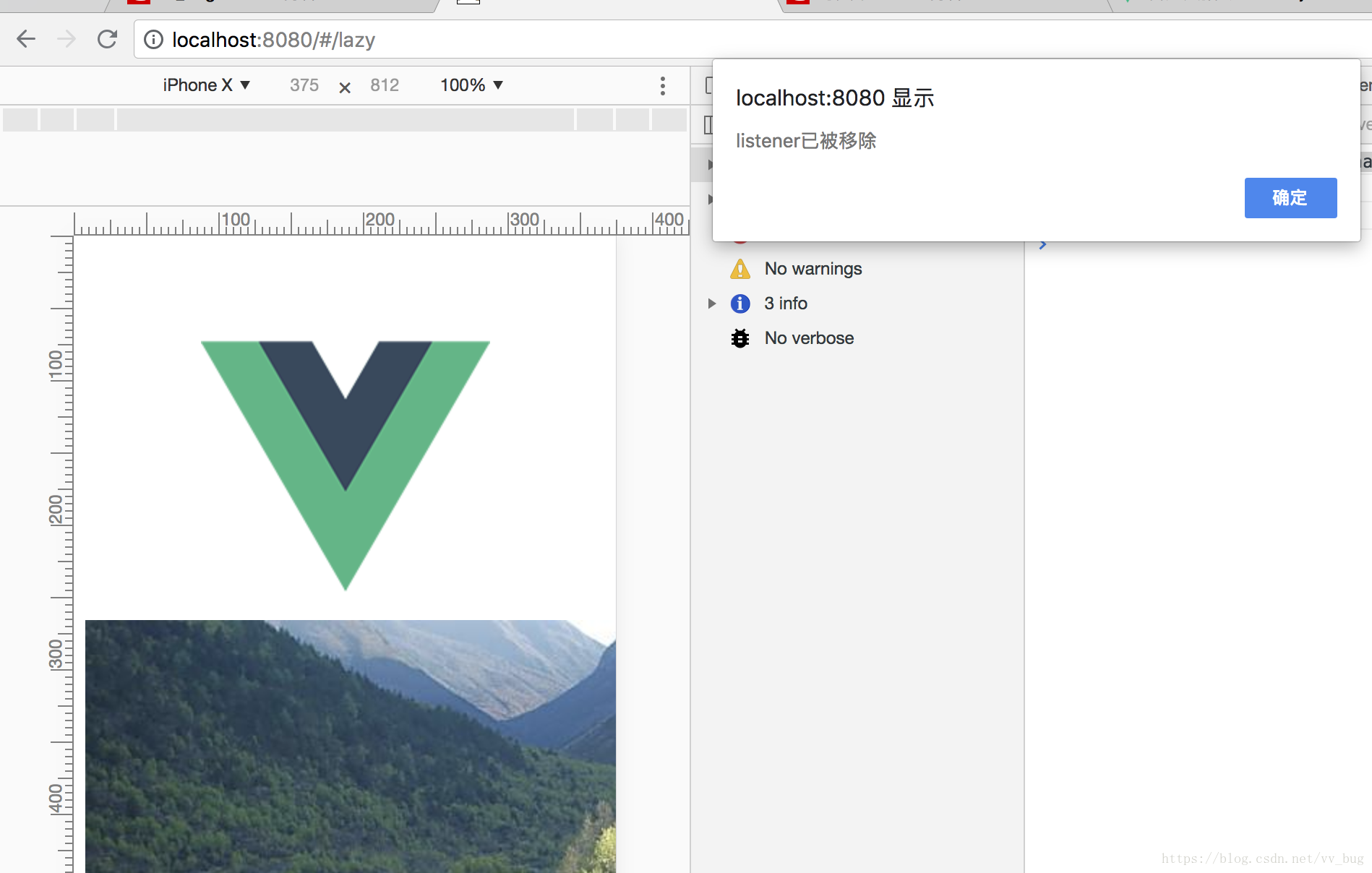
可以看到,我们的框架已经搭建的差不多了,现在有一个这样的需求,当我们的图片很多的时候,我们只需要加载我们看到的部分,当滑动到其它部分的时候再去加载(以时间换空间),现在我们是直接一出来就加载全部图片(以空间换时间), 如果是在pc端的话,我们可以直接加载全部,这样快,而且pc上貌似内存问题还不是很大的问题,但是当到手机端的时候,内存的占用直接影响的是用户体验,所以我们需要用懒加载的方式去加载图片——
好啦!!! 下一节我们继续哈~~ 还是那句话
欢迎入群,欢迎交流~~~~
qq群号:






 本文介绍如何使用Vue实现图片懒加载功能,包括基本框架构建、监听图片加载状态、更新图片源等关键技术点。
本文介绍如何使用Vue实现图片懒加载功能,包括基本框架构建、监听图片加载状态、更新图片源等关键技术点。
















 617
617

 被折叠的 条评论
为什么被折叠?
被折叠的 条评论
为什么被折叠?








